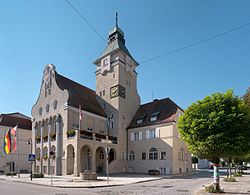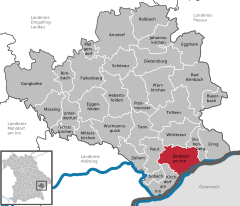
Braunau am Inn is a town in Upper Austria on the border with Germany. It is known for being the birthplace of Adolf Hitler.
Rottal-Inn is a Landkreis (district) in the southeastern part of Bavaria, Germany. Neighboring districts are Altötting, Mühldorf, Landshut, Dingolfing-Landau and Passau. To the southeast is the Austrian state of Upper Austria (Braunau).

Piding is an approved climatic spa in Bavaria near to the border of Austria close to Bad Reichenhall and Freilassing.
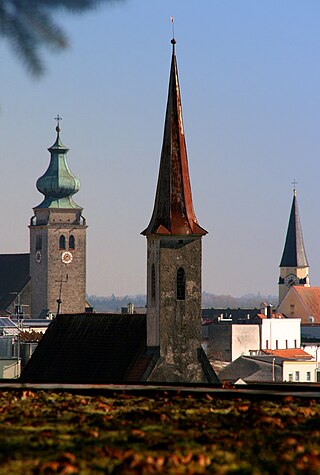
Mühldorf am Inn is a town in Bavaria, Germany, and the capital of the district Mühldorf on the river Inn. It is located at 48°14′30″N12°31′30″E, and had a population of about 17,808 in 2005.

Marktl, or often unofficially called Marktl am Inn, is a village and historic market municipality in the state of Bavaria, Germany, near the Austrian border, in the Altötting district of Upper Bavaria. The most notable neighbouring town is Altötting. Marktl has approximately 2,800 inhabitants.

Bundesautobahn 94 is an autobahn in southern Germany. When completed, it will connect Munich with Passau. Currently, only the parts Munich-Burghausen, and a small section in Malching have been built. Between Burghausen and Simbach am Inn, there is a 14 kilometer, two-lane section that is signed as Bundesstraße 12. Provisions for an upgrade to A 94 exist here.

The Innviertel is a traditional Austrian region southeast of the Inn river. It forms the western part of the state of Upper Austria and borders the German state of Bavaria. The Innviertel is one of the four traditional "quarters" of Upper Austria, the others being Hausruckviertel, Mühlviertel, and Traunviertel.

Oberndorf bei Salzburg is a small city in the Austrian state of Salzburg, about 17 km (11 mi) north of the City of Salzburg. It is situated on the river Salzach in the Flachgau district. Town privileges were granted on April 30, 2001.
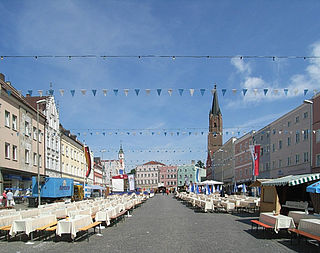
Eggenfelden is a municipality in the district of Rottal-Inn in Bavaria, Germany.

Grafing bei München is a town in the district of Ebersberg, Upper Bavaria, Germany.
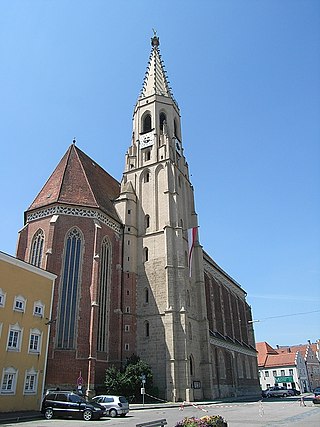
Neuötting is a town in the district of Altötting, in Bavaria, Germany. It is situated on the river Inn, 2 km north of Altötting, about 70 km north of Salzburg, 80 southwest of Passau and almost 100 km east of Munich. It is a stop on the railway line between Munich and Simbach.

Anzing is a municipality in the Upper Bavarian district of Ebersberg.

Bad Griesbach im Rottal, or just Bad Griesbach, is a town in the district of Passau in Bavaria in Germany.

Neuburg am Inn is a municipality in the district of Passau in Bavaria in Germany.

Kirchdorf am Inn is a municipality in the district of Rottal-Inn in Bavaria in Germany. It lies on the river Inn.

Zeilarn is a municipality in the district of Rottal-Inn in Bavaria, Germany.

Waging am See is a municipality in the district of Traunstein in Bavaria, Germany. The town, classified as a climatic spa, is located at the Waginger See, the warmest lake in Upper Bavaria, with temperatures up to 27 °C.

Haigermoos is a municipality in the district of Braunau am Inn in the Austrian state of Upper Austria. Today nothing remains of the infamous Weyer concentration camp for Roma placed here before 1945.
The Mühldorf–Simbach am Inn railway is a 39 km long, single-tracked, unelectrified main line in Bavaria in southern Germany.
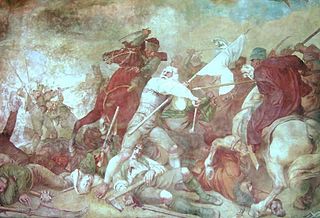
The Bavarian uprising of 1705–1706 was a revolt against the occupation of the Electorate of Bavaria by the Imperial Army of the Habsburg Monarchy during the War of the Spanish Succession (1701–1714). It lasted from early November 1705 to 18 January 1706, approximately 75 days. Henric L. Wuermeling speaks of this as "the first revolution of modern history."
